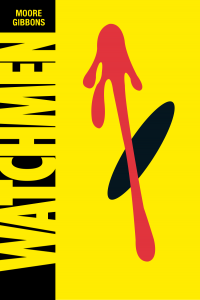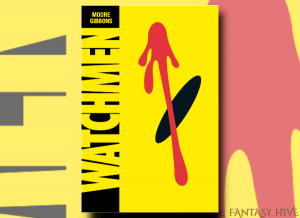WATCHMEN by Alan Moore and David Gibbons (BOOK REVIEW)
This Hugo Award-winning graphic novel chronicles the fall from grace of a group of super-heroes plagued by all-too-human failings. Along the way, the concept of the super-hero is dissected as the heroes are stalked by an unknown assassin.
One of the most influential graphic novels of all time and a perennial best-seller, Watchmen has been studied on college campuses across the nation and is considered a gateway title, leading readers to other graphic novels such as V for Vendetta, Batman: The Dark Knight Returns and The Sandman series.
I’m still fairly new to the graphic novel format but Watchmen was a recommendation by my son in law who kindly loaned me his copy. The book is a 1987 omnibus edition of 12 DC comic books that came out monthly in 1986-7 (in a similar way to Dickens novels all having been first published as serialisations). So I am coming somewhat late to the party of enjoying this remarkable example of the graphic novel genre.
The graphic story telling form is a different reading experience. With conventional text I am used to seeing (often fragmentary) images in my head as I self-illustrate the narrative. It is one example of the way that we immerse ourselves and actively respond to the text. However, while the printed word may have been the medium through which individuals could consume stories for centuries, there has been something of a sensory explosion in the last hundred years. Films, audio books, multimedia delivery and even epistolary detective mysteries, are all giving us new ways to experience stories. I do wonder how those different modes of access affect our responses to the stories. For example, film watching is a more passive experience than book reading, with the director entirely controlling what we see and hear. In a similar way the images in a graphic novel take some of the proactive independence away from the reader and that might explain why it took me a little while to settle into the story of Watchmen.
 However, once past the first couple of chapters I found the intriguing characters and imaginative setting had quite captured my imagination and I was becoming more comfortable around the mix of tangled storylines in panelled images with epistolary or archival interludes separating the chapters. The narrative built to a very pleasing twisting conclusion.
However, once past the first couple of chapters I found the intriguing characters and imaginative setting had quite captured my imagination and I was becoming more comfortable around the mix of tangled storylines in panelled images with epistolary or archival interludes separating the chapters. The narrative built to a very pleasing twisting conclusion.
The main thread of the story focuses on a few months in the fall (Autumn!) of 1985 in an alternative version of contemporary America. However, through flashbacks and more text-based interludes we delve into the past of all the characters and the book gives a convincing sense of a coherent whole. It can be a little confusing, as we meet characters before we get their backstories – particularly when the blue guy turns up – but the immersive approach works well and I was happy to be swept along by it. There is even a bonus zombie pirate tale that gets interleaved with the main narrative, as though the writers had a story searching for a home, or perhaps just wanted to amuse us and themselves in a meta-fictional way by inserting a graphic story within a graphic story.
The eponymous Watchmen (and watchwomen) are a group of mostly retired “costumed heroes” who, by 1985, are past their physical and legal prime. Most fall into what you might think of as the Batman category. By that I mean ordinary mortal humans enhanced – through various permutations of physical training, technological gadgetry, martial prowess, and superior intellect – to facilitate their masked crime fighting spree. One – the blue skinned Jon, or Dr Manhattan – is more in the Superman league, or even supraman, in that his powers do appear pretty boundless.
The various backstories chart the arc of this cluster of heroes from pre-war depression era vigilantes through two generations as various newcomers join their ranks, up until their legal disbanding with a 1977 act outlawing their encroachment on the proper authority and jurisdiction of the police.
So, by the present time of the story, the Watchmen are largely marginalised and forgotten until one of them is murdered – and in essence the story is a murder mystery as we follow one defiantly unretired Watchman, Rorschah as he investigates the death. The story takes place against a backdrop of rising tension between East and West, reflecting what was then the pre-Glasnost era with nuclear war being the most feared and relevant form of planetary Armageddon. The backdrop and the foreground narratives merge pleasingly in the final denouement.
The world is a sort of a parallel universe, the conceit that allows the writers to plant world defining events in the familiarity of an utterly contemporary setting. The story is not confined to a fictional Gotham City but sprawls across the real world from Antarctica to New York with a brief sojourn on Mars. In this distorted version of the real world an aged white-haired Nixon is still President and it appears that Dennis Healey has become the UK prime-minister.
The Watchman are a varied bunch, one has to warm to Rorschah, the underdog and street warrior with a stubborn conscience, while Dan the heir to NiteOwl’s mantle is an endearing technocrat in something of a mid-life crisis. The Comedian is wonderfully ironic since he is the least funny and most arrogantly repugnant of the Watchmen. Jon the blue skinned supraman is wonderfully confined by the unlimited nature of his own powers, foresight becomes a curse when it only means seeing the inevitable without the possibility of avoiding it. Possibly showing its era, the main female lead – Laurie who inherited the silk spectre title from her mother and has become the lover of Jon – appears to be a sounding board for the plots and struggles of the male characters, rather than having much agency in her own right.
Both the writing and the artistry are full of flashes of humour – such as when one character is effortlessly depicted in successive panels holding off the assault of another, while simultaneously having a conversation with a third – a nice separation of action and dialogue that the form lends itself too. The dialogue too has its laugh out loud moments and the combination of image and text tempts one into a re-read with the sense that there are more secrets and Easter eggs to be unearthed than in a conventional novel.
As with many beloved books and series of the past, there are aspects of the story – like the superannuated heroic watchmen themselves – which show their age. The handling of issues like rape and homosexuality feel authentic to the era but perhaps a little dated to modern eyes. That discrepancy highlights the constant evolution of social attitudes. Each era can fall so easily into the fallacy of thinking that how it is now is how it has always been – that contemporary standards and expectations are somehow eternal and immutable. The truth is that society, like the individuals within it, is a constantly growing and developing organism. While we feel we are somehow the same person we were as a young adult we are (thankfully) in many ways very much different and – no matter how old we might be – will go on learning, growing and changing. The personal and collective trajectory of the Watchmen nicely illustrate this point – they have been aged and changed by their experiences.
There are themes that Watchmen still speaks to – around the tribal nature of nationalism where we seek always to divide a people into us and them (or as they say here in Belfast Us’uns and them’uns). The plot pivots around the fact that ultimately it might need an external threat (like the Alien invasion of Independence Day) to recognise our common humanity and appreciate that we are all really us’uns. There is then the question of how far achieving that epiphanaic end might justify the means. What sacrifices are necessary and appropriate to end all sacrifice. Watchmen’s version manages to be a far darker one than Aslan on the stone table.
Those politics of division have a certain resonance today, though the lines appear to be being drawn within rather than between nations, with political polarisation and demonisation of the woke left. It’s telling how far that era of communist-capitalist division continues to haunt our world. As Oreskes and Conway highlight in Merchants of Doubt (2010), there has been a migration of people behind the political, economic and scientific consensus that opposed communism into one that demonises and opposes climate change action. Capitalism in the absence of old external enemies that helped forge a collective sense of unity is finding internal enemies and helping to polarise our societies. They smear attempts to address the climate crisis with the old messages that action will impoverish, enslave and destroy western civilisation. There was a dreadful headline I saw recently – Net Zero is a Trojan Horse for the destruction of Western Society (Heath, 2023). The fear and hate that form the backdrop to Watchmen have been repurposed in our times. One wonders what externally driven catastrophe might be needed to knock sense into the movers and shakers of this world. Where Watchmen envisages one terrible individual visionary, Jon Raymond in Denial (2022) foresaw a more ground level raising of awareness into collection action in the Upheavals of 2030. Either way we need to do something soon, for while the fall of Berlin Wall might mean we have substantially dodged the nuclear bullet that haunts the pages of Watchmen, Climate change is a juggernaut less easily evaded.
References
Heath, A. (2023, March 29). Net Zero is a Trojan Horse for the total destruction of western society. Retrieved from www.telegraph.co.uk: https://www.telegraph.co.uk/news/2023/03/29/net-zero-trojan-horse-total-destruction-western-society/
Oreskes, N., & Conway, E. M. (2010). Merchants of Doubt: How a Handful of Scientists Obscured the Truth on Issues from Tobacco Smoke to Global Warming. London: Bloomsbury Press.
Raymond, J. (2022). Denial. New York: Simon & Schuster.

